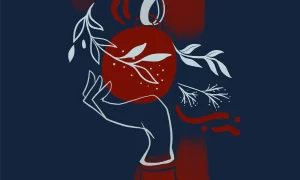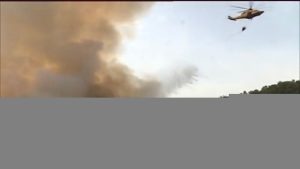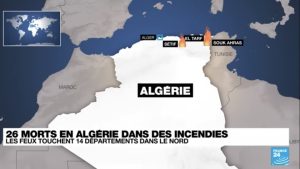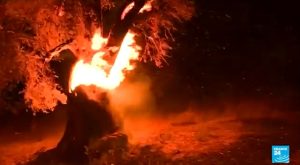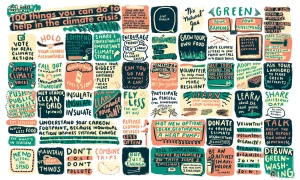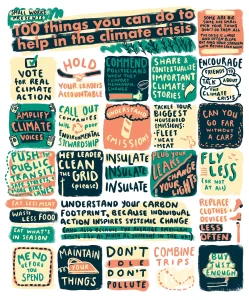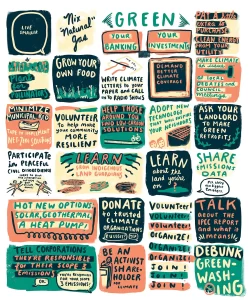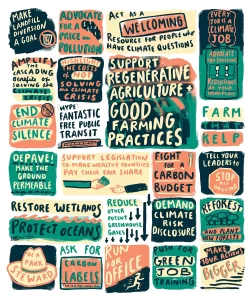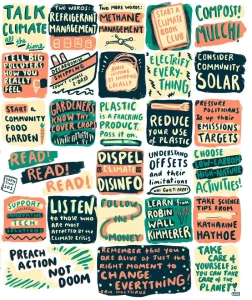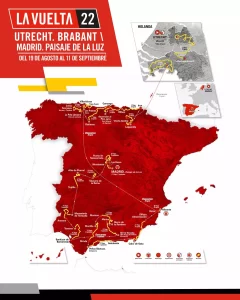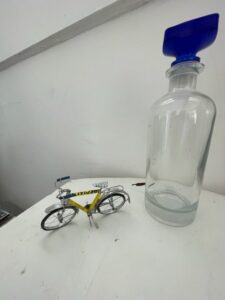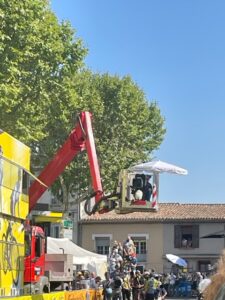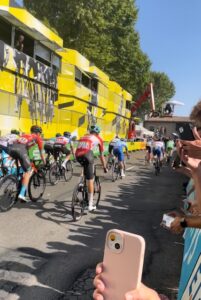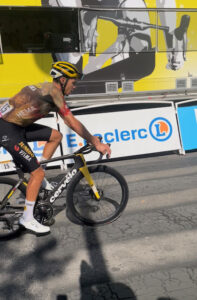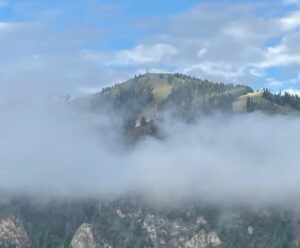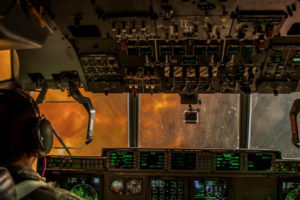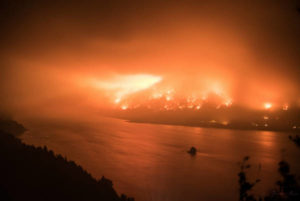Fires
Dayle in Limoux – Day #44
August 18, 2022We are not alone. The wise ones who walked before us have left luminous footprints for us to follow in our own apocalyptic time.
‘It takes a contemplative mind to spend months living and working in relative isolation because of a devastating pandemic—and not lose hope.’
♡
-Mirabai Starr
Julian of Norwich
John of the Cross
More from Mirabai.
‘Mystics see through a lens of paradox: dazzling darkness, beautiful wound, the longing that is the remedy for longing. Paradox points beyond itself to a truth that both transcends and includes logic, a truth that is alive, generative, and whole. Such a dynamic mode of knowing demands our complete attention. . . .
What does a religious woman who dwelt in an anchor-hold during the Middle Ages have to do with you and me today? Julian endured a long and cruel pandemic. The disease ravaged her community and carried off the people that she loved. She learned to shelter in place, focusing on cultivating her interior landscape and sharing the fruits of her wisdom through the window that opened from her cell onto the busy streets of her city (think computer screen and Zoom), where she offered counsel to visitors . . . each day.
And how could a renegade monk, who survived the Spanish Inquisition despite the Jewish and Moorish blood that flowed through his veins, have anything to teach us about flourishing in our own dark nights? John of the Cross illumines the transformational power of radical unknowing. He rekindles our latent longing for union with the Beloved and, through sublime poetry and precise prose, blows on the flames so that they dance back to life in our
beleaguered hearts.
He reminds us that when everything in us wants to rush out and fix the problem of our brokenness, both individual and collective, the wisest and most loving thing to do is to be still, letting go of our attachment to the way we thought the spiritual life was supposed to feel and the sense we assumed it should make.
Once we step out of our own way, into the dark and empty vessel of the soul, “an ineffable sweetness” will begin to rise, permeating and nourishing the quiet earth, uncovering a resurrection we never dreamed possible: a dazzling darkness, a radiant night, a revolutionary newness
of being.’
(This essay, and others, is included in the Oneing/Unveiled book illustrated above.)
Our ancestors, on standby and ready for our inquiry. Reading earlier this morning from YES! Magazine:
Defenders of the system [Capitalism/Philanthropy] cannot rightfully claim they were not warned. There are warnings against overreach and hubris in the founding myths, literature, poetry, and scriptures of nearly every culture on Earth. In Western literature, for example, the monster in Mary Shelley’s Frankenstein (1818), for one, is not the creature but its creator, who refused to take responsibility for what he’d done. Herman Melville’s Captain Ahab in Moby-Dick (1851) is a further warning about the penalties that accompany uncontrolled obsession in pursuit of ignoble ends. Fyodor Dostoevsky’s Grand Inquisitor gave a further warning about the perverse logic of necessity; in The Brothers Karamazov (1879), the Grand Inquisitor says to a silent Christ: “In the end they [the people] will lay their freedom at our feet, and say to us, ‘make us your slaves but feed us.’ They will understand at last that freedom and bread enough for all are inconceivable together … they can never be free for they are weak, vicious, worthless, and rebellious.”
Good essay.
‘Sometime after Adam Smith published ‘The Wealth of Nations’ in 1776, the logic of brute force infected Western economics, informing its underlying proposition that all men (mostly) have insatiable wants that justify tearing up the earth, polluting it, or frying it to death. By this logic, human survival is deemed uneconomical. But why would any even modestly sane person run the risks of destabilizing the Earth’s climate? It is impossible to comprehend the depth of nonsense in waters so turbid.’
The Disaster of Philanthropy and Capitalism
by David W. Orr
C
L
I
M
A
T
E
B R E A K D O W N
Reading about the fires in Algiers, 38 have perished thus far in this rapid and large burning fire. The planet is burning. Gaia is crying for our help.
France 24:
‘Forest fires that ravaged 14 districts of northern Algeria—a country with an already limited amount of forest.’
The country is south of Spain and east of Morocco.
Everyday I feel as though all news and information should rake away anything that doesn’t deserve what should be the planet’s number one priority: C L I M A T E. Imagine if the media focused on climate like they do president #45. I mean, if we don’t have a planet that is inhabitable, and vast majorities of people are migrating to simply live, it probably won’t matter a whole heck of a lot what he did, what he’s going to do, or what he blabbered about at a rally.
Learning that we can all do our part, however small our gesture or effort, like eating less meat, driving/flying less, removing lawns, reuse, change out older appliances (CFC’s), and lastly, hugely, V O T E for candidates who 1. Believe in climate breakdown and 2. Will work to save our planet, release the grip on U.S. fossil fuels, and amplify every step of progress that could heal our planet, collective micro efforts will create shift. WE MUST ‘LOOK UP.’ From YES! magazine:
100 Things You Can Do to Help in the Climate Crisis
In case you needed help getting started.
A New Social Justice: Solutions We Love
[YES! Magazine]
‘To heal ourselves, we must remember that we are a small part of a much greater whole.’
-Adrienne Maree Brown.
~
Buying real estate is France. Some incredible finds and quite affordable, especially when comparing housing prices in the u.s.a. right now. This is fun. A couple of guys bought a village (!) in France.
More from Julian of Norwich, lyrics based on her well-known and often shared quote:
“All shall be well, and all shall be well and all manner of thing shall be well.”
Receive the gift of healing
from the well of tears;
be washed anew
by grief and sorrowing.
Receive the gift of healing
from our mother Earth,
her deep and dark
and secret verdancy.
Receive the gift of healing
from the shaman’s touch:
the wounded healer’s power
to revive.
Receive the gift of healing
in the arms of love,
embraced in passion
and compassioning.
—
Covid. It is not over. 500 people are still dying every day in the United States. Here in France absolutely no mitigation. Many people are out and about coughing, congestion; could all very well have Covid. Even the woman who own my building, back from the hospital after two weeks, being in a coma and on respirator, will not wear a mask. Or her family. She is getting stronger, her breathing more fluid. Thank, Gaia. Yet she has not fully recovered. So. Doubling down. Again. My heart is so sad knowing how many immune compromised stay in isolation, many away from friends and co-workers…families…because they can not chance being ill. There is still so little known about the disease and it’s long-term effects. From Axios:
‘A new large-scale Oxford University study finds that people who’ve had COVID face increased risk of neurological and psychiatric issues — brain fog, psychosis, seizures, dementia — for up to two years after infection.
- The study found anxiety and depression are more common after COVID, though typically subside within two months of infection, Axios’ Rebecca Falconer writes.
Why it matters: The study, published yesterday in the Lancet Psychiatry journal, is the “first to attempt to examine some of the heterogeneity of persistent neurological and psychiatric aspects of COVID-19 in a large dataset,” an accompanying editorial says.
And Monkeypox, reportedly can infect asymptomatically. And now polio is back due to lack of vaccines in countries like Pakistan and Afghanistan; travelers/migrants can bring those viruses into another country, and many parents have opted not to vaccinate. A man in New York who contracted the polio virus is now paralyzed. Apparently, some of the vaccines…not in the U.S….vaccinate with a ‘live’ virus and that can be problematic when they do travel. This is what reportedly happened in New York, according to one doctor. And with our climate breakdown, will be seeing, and contracting, more viruses. The CDC’s choice to basically eliminate precautions, i.e., physical distancing and isolating when testing positive, is baffling.
VUELTA❗️ Starts tomorrow in S P A I N! 🚴🏻
CyclingNews:
‘The 2022 Vuelta a España starts on August 19 in Utrecht, Holland, and ends in Madrid, Spain, on September 11. The 21 stages include a team time trial, an individual time trial, several flat stages and nine of the often-steep uphill finishes the Vuelta has become known for.
Two years after the pandemic caused a postponement of the Vuelta a Espana’s Dutch start, Utrecht will finally become the first city in the world to organise the opening stage of all three Grand Tours after the Tour de France in 2015 and the Giro d’Italia in 2017.’
Jusqu’à demain.
✿
Dayle in Limoux – Day #13
July 18, 2022Started ce jour with the bells of Saint-Martin. Then, the adventure began!
Ode to Le Tour. Found it at a local marche…the bike of the maillot jaunt.
Knew it was going to be unbearably hot with the heat dome over Europe, fires burning.
I was thinking last night that although the Tour is winding through Limoux, the final stage before rest day on Monday was finishing in Carcassonne. I decided to take the bus (sometimes a train, not sure how it’s determined) and see what I could find. What I didn’t anticipate when I was riding into Carcassonne is the Tour route would effect our drop zone which is typically la gare, the train station. We made numerous detours and then landed in an area I wasn’t familiar. The driver, who apparently took a wrong turn and had to back the bus up…impressive…didn’t speak any English and after trying to communicate in my weak French, she mimed that I should follow the other people. Many didn’t know how to trek the long walk back to the train station, so we grabbed our phones and fired up our maps. Finally made it to the city center and just started looking for the tour. Already rationing my two large bottles of Perrier because of the heat with no idea what was about to unfold!
Then, the adventure began!
I spotted splashes of yellow. 🟡
I started trekking to find the route to the finish. I found a spot just past the finish line and since it was early and a lot of the spectators hadn’t filled in yet, I settled into my space.
There was music and announcing, and sponsors of the tour handing out all their tchotchkes. Very fun. A bike cap, a Skoda bag, a polyester vest…trop chard to wear…a bucket hat, too! Just like Emily in Paris. :)
My favorite sponsor gift and probably kept me from heat exhaustion, literally, was a sparkling canned beverage. Yummy. Their vender came back and gave me three more (!) and somebody else was handing out bananas. She was so sweet. Trop chaude! So grateful. It really helped.
I couldn’t sit on the asphalt because it burned my bum it was so hot. Five hours of standing in 41 C heat…106 Fahrenheit. Brutal. And so fun. I kept thinking about the guys racing in this heat. I was standing and trying not to pass out. They were biking hard and fast, sometimes their speeds clocked in at 72 KPH (45 MPH on the stage). Many climbs. The Tour put special heat protocols into place because of the dangerously high temperatures. Some of the guys, it was reported, wanted the stage to actually be cancelled due to the heat. With a warming climate and the devastation it is causing, maybe the Tour will need to be moved to the edges of the season in the Tours ahead. Our world is changing…fast.
When the riders get close, all the vehicles start driving in! The sponsors, the team buses, the team cars, the press motorcycles (So fun seeing Bradly Wiggins come in with his motorbike driver. And then there’s a fun parade with the sponsors and their vehicles.
Jumbo Visma’s bus! Many excited to receive it. When they went past, many in the bus didn’t look happy. Come to find out they lost two riders today, one to injuries over the course of the Tour, and another rider after a crash due to more protesters who were blocking the middle of the road.
The Tour is a massive and masterly organized operation; they set-up and tear-down for every stage and it’s all seemingly seamless.
That’s how they get those awesome finish shots. With the camera operator in place, we all knew it was getting close.
All the superfluous vehicles and dignitaries removed, it was quiet. Then the overhead finish screen, “4 kilometers to go!” Cameras ready, the pounding of the placards begins. And then the guys bolt around the final bend. Sprint finish! Wout in the green, couldn’t make out the other two, thought it might be Fabio Jakobsen from Quick Step who replaced Mark Cavendish. (Thought about him so much today; would love to have seen him.) I positioned my camera, hoped for the best, yet I wanted to watch it live! The clip worked although it was holding it low so I could see the riders! It was thrilling and so knock-out fast. How is that kind of power, control, and stamina able to be sustained after 106 degree weather and 202 kilometers! It’s nuts. Incredible, unbelievable athletes. They love Le Tour in Carcassonne. Moi Aussi. (Me, too!)
I’ve been trying for hours to get the video from my iPhone to this website…not working. So I did some screen captures. If I’m able to figure it out, I’ll edit and re-post later. Crazy exciting!
S
O
F
A
S
T
WOUT! Right in front of me!
And Sepp Kuss from Jumbo Visma. They’re going to need him so much now after losing two key riders. Incredible domestique and all around talented rider, 27 years old from Durango, Colorado. One of my favorites to watch. So happy I spotted him! Looks depleted and beat. Much needed rest day tomorrow.
The best. Vive Le Tour! 💛
And a sweet post-stage interview with the sprinting finish winner for stage 15, Jasper Philipsen. Rock ⭐️. He’s worked so hard for this moment. Very emotional. First stage win at the Tour. At the 12:15 mark.
AND! Images of the podium. So. Many. People. I was the only one I could see wearing a mask besides the riders and worker bee’s. 😳
The beast. Wout van Aert keeps the sprinter’s green!
Jonas Vingegaard keeps yellow and his time distance from Tadej. They are so equally matched.
Stage winner and first Tour de France stage win, Jasper Philipsen.
Battling for the yellow…still holding the youngest winner jersey, Tadej Pogacar. His team, UAE, and Jonas’ team, Jumbo Visma, are struggling with dropped teammates, after Jumbo’s dominance. The Tour is wide open!
King of the Mountain jersey winner, Germany’s Simon Geschke. Lots of fans at Stage 15!
And these guys. Best seat on the Tour! They had a clear shot of the finish and the podium.
Or, maybe this guy. :)
18 years since I’ve been at the Tour watching Lance win his 6th with his gold helmet down the Champs-Élysées. (Thank you, Theodore.) Carcassonne was
A M A Z I N G
Incredible experience. Beautiful country and people. Now, I need to keep hydrating, cool down, and replenish for Tuesday’s stage 16 as it goes through Limoux, about 1:15 pm local time!
Bonne nuit.
❀
Beyond why.
September 9, 2017“For so many years, talking about the weather was talking about nothing. Now it really is our survival.”
-Terry Tempest Williams
“Climate change debate is over, now it’s about climate adaptation.”
-Craig Fugate, former director of the Federal Emergency Management
︶⁀°• •° ⁀︶
We must change the narrative. The planet has drastically and rapidly moved beyond the ‘why’ of climate change. The collective needs to desperately and pragmatically admit the climate has indeed ‘changed’. The Earth’s equilibrium has been altered. How do we live in this new ecosystem while protecting, and taking care of each other…and Gaia? The earth needs to know we are trying.
Inside Climate News
Potent Mix of Record Heat and Dryness Fuels Wildfires Across the West
by Georgina Gustin
Wildfires burned across hundreds of thousands of acres in the American and Canadian West this week, fueled by scorching temperatures that are breaking heat and fire records across the region.
In California, while temperatures have eased, at least 15 cities have seen record-breaking heat, and the state has experienced its hottest summer on record. San Francisco hit 106 degrees over the weekend, breaking its previous high by 3 degrees. Stoked by unusually high temperatures, fires burned on thousands of acres just outside Los Angeles, while firefighters in Washington, Oregon and Montana battled dozens of blazes across those states.
By the end of the day Tuesday, at least 81 large fires were blazing across 1.5 million acres of the U.S. West, from Colorado to California and north to Washington. Over the Canadian border, British Columbia has already had a record-breaking fire season—and it’s not over yet. Cities including Seattle were shrouded in a smoky fog. In satellite pictures, the smoke could be seen traveling the jet stream and reaching the East Coast.
As firefighters battled the blazes, climate researchers pointed to studies finding that a warmed global atmosphere, with increasingly clear human fingerprints, will continue driving a potent mix of heat and dryness that’s projected to escalate in the West.
“These unprecedented extreme events, on the daily to the seasonal scale, are exactly the types of events that are more likely due to the global warming that’s already occurred,” said Daniel Swain, a climate scientist at UCLA. “That’s not so much a future projection, but an observational reality, and that’s something we expect to increase in the future. When we get these extremes, there’s a human fingerprint.”
Swain co-authored a study led by Stanford researcher Noah Diffenbaugh published earlier this year that found human-caused greenhouse gas emissions have increased the chances of extreme heat across more than 80 percent of the globe’s surface area.
“The increased occurrence of severe heat, and the role of global warming on the occurrence of severe heat—that’s already happening,” Diffenbaugh said. “It wouldn’t be scientifically credible to make attribution statements without analyzing the event. That being said, we can see the odds of setting new records based on the global warming that’s already happening.”
While drought and high heat aren’t the only factors making wildfires more intense and frequent—researchers also blame encroaching development into wild areas and certain wildfire management practices—they are key drivers.
Nine of the 10 worst fire seasons in the past 50 years have all happened since 2000, and 2015 was the worst fire season in U.S. history, surpassing 10 million acres for the first time on record. So far this year, wildfires in the U.S. have burned 7.8 million acres, but the fire season is far from over. (In 2015, 8.4 million acreshad burned by early September.) The average fire season is 78 days longer than it was in the 1970s—now nearly seven months—beginning and extending beyond the typical heat of summer. By April of this year, wildfires had scorched more than 2 million acres in the U.S.—nearly the average consumed in entire fire seasons during the 1980s.
Last fall, researchers published the results of a study that found human-induced climate change accounted for about half the observed increase in fuel aridity, or forest dryness, in the western U.S. since 1979 and had nearly doubled the area of the U.S. West affected by forest fires since 1984.
During that same time period, temperatures across the West have risen. Temperatures are projected to rise further—and along with them, the tinderbox conditions that fuel wildfires.
“We know that global warming has already increased the probability of unprecedented high temperatures in the western U.S., including in California,” Diffenbaugh said. “And we know, with high confidence, that continued global warming will continue to intensify those increases.”
A forest fire spread along the Columbia River Gorge on Sept. 5, 2017. Credit: James C. Kling/CC-BY-2.0
The Atlantic
Has Climate Change Intensified 2017’s Western Wildfires?
It was supposed to be a quiet year.
by Robinson Meyer
Last winter, a weak La Niña bloomed across the Pacific. It sent flume after flume of rain to North America and irrigated half the continent. Water penetrated deep into the soil of Western forests, and mammoth snowdrifts stacked up across the Sierra Nevadas. California’s drought ended in the washout.
Yet fires are now raging across the West. More than two dozen named firescurrently burn across Washington and Oregon. More than one million acres have burned in Montana, an area larger than Rhode Island, in the Treasure State’s third-worst fire season on record. And the largest brushfire in the history of Los Angeles currently threatens hundreds of homes in Burbank.
A firefighter battles the Ponderosa Fire east of Oroville, California, in late August. Noah Berger / Reuters
Canada may be experiencing an even worse year for wildfires: 2.86 million acres have burned in British Columbia, the largest area ever recorded in the province.
So what happened? How did a wet Western winter lead to a sky-choking summer?
The answer lies in the summer’s record-breaking heat, say wildfire experts. Days of near-100-degree-Fahrenheit temperatures cooked the Mountain West in early July, and a scorching heat wave lingered over the Pacific Northwest in early August.
“This will become an important year for [anecdotes about] the importance of temperature. Despite the fact that these forests were really soaked down this winter and spring, these heat waves have dried things out enough to promote really large fires,” says Park Williams, a research scientist at the Lamont-Doherty Earth Observatory at Columbia University.
“Since the 1980s, we’ve only burnt about 10 percent of the western U.S. forests. And that number to me means that there’s still a whole lot more to burn,” Williams said. He estimated that it would take another several decades for that excess century of fuel to burn out of the American woods. And in the meantime, the planet will only get hotter.
“According to climate models, by the end of this century, the western United States is still projected to warm by about another 3.5 degrees Celsius,” he told me. “And when we remember that the relationship between temperature and fire is exponential … we’re really talking about a very different western United States in 50 years.”

